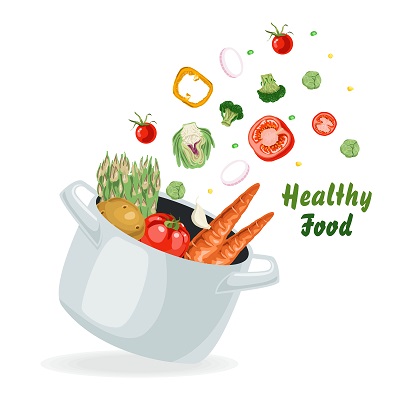 Since discovering the effects nutrition has on weight and health, many people are looking for ways that they can make their home cooking healthier.
Since discovering the effects nutrition has on weight and health, many people are looking for ways that they can make their home cooking healthier.
It’s no surprise that there is a lot of information available and that much of this information is contradictory. Depending on which nutritional philosophy you follow, you may get different answers.
No matter your approach to nutrition, there are some basic cooking principles that will apply to you. These five secrets to healthier cooking can be used in any diet or way-of-eating.
Change the Colors
The wider variety of colors that your food comes in, the more varied your nutritional intake will be. The deeper the color of the food the higher the concentration of micronutrients.
Some of the best ways to get this great nutrient boost is to avoid overcooking your colored fruits and vegetables. A boiled carrot has less beta-carotene than a raw carrot. The same can be said of any other vegetables.
Many fruits and vegetables have important nutrients in the skin. Cucumbers, for example, have most of the fiber and nutrients in the outer peel. When possible avoid peeling the skin off your vegetables. Instead, try to scrub the outer skin clean with a sponge or vegetable wash.
Try Rye
Many grains can cause a spike in insulin. The rise in insulin is associated with appetite and mood swings. One grain that doesn’t cause a rise in insulin is rye. Because rye does not cause a spike in insulin, it can be used as bread, sandwiches, and toast.
Having a grain option that will not spike insulin can be useful for many populations eating for health.
Get More Fiber
Fiber is a wonderful tool for keeping you full and eating digestion. Sources of fiber include fruits, vegetables, and whole grains. If you enjoy toast with your morning breakfast switching to a whole-grain toast or rye toast, will provide you with more fiber.
In addition to switching your toast out for whole grains in the morning, you can change your white rice for whole grain rice. Whole-grain versions of rice include brown rice, black rice, and other unbilled versions. You can also add things like bulger, quinoa, and couscous into your diet to get more whole-grains.
Some of the best sources of fiber are deep green leafy vegetables. Including spinach, mustard greens, collard greens, and other deep green vegetables. Getting these into your diet will increase your fiber intake. Fibrous fruits include most berries. Berries also have a low sugar content making him a great snacking option.
Ultrafine Shredded Cheese
One way to decrease your overall calorie intake is to use the cheese. Most people don’t want to cut back on their cheese, so a simple hack is to use an ultrafine shredder. WebMD notes that using an ultrafine shredder to shred your cheese will allow you to cover more surface area with less cheese.
You’ll get all the flavor you want without using quite as many of your daily calories.
Choose the Right Fat
Not all fats are created equal. Fats like olive oil are better for you than saturated fats. Eating Well notes, the best fats are going to have a high portion of omega-3 fatty acids. Omega-3 fatty acids are essential to combating the damage done by oxidation and omega-6 fatty acids.
Fats high in monounsaturated fat are going to be better for you than those containing polyunsaturated fat.
Monounsaturated fat is more stable to use when cooking because there is less breakdown during the heating process.
If you are trying to get healthy, it can be confusing to know where to look. Luckily, we have a list of five tried-and-true methods for keeping your cooking healthy. If you follow these simple steps to healthy eating your sure to see an improvement in the quality of your nutrition.






